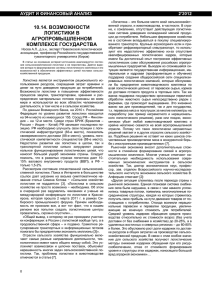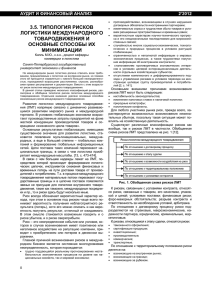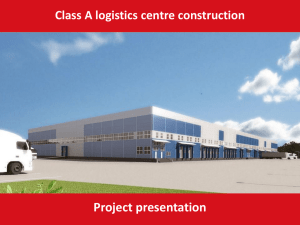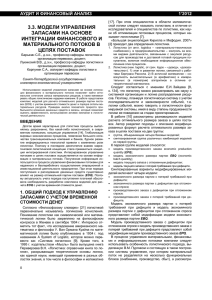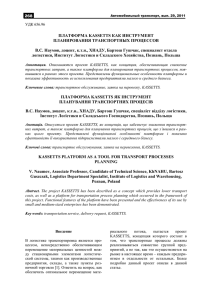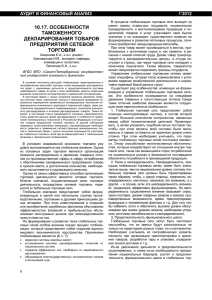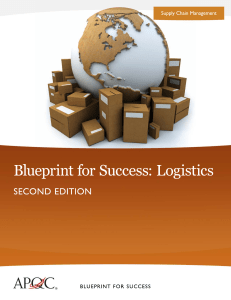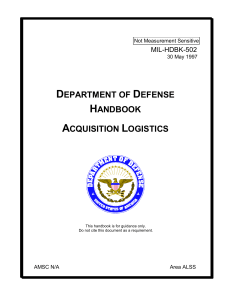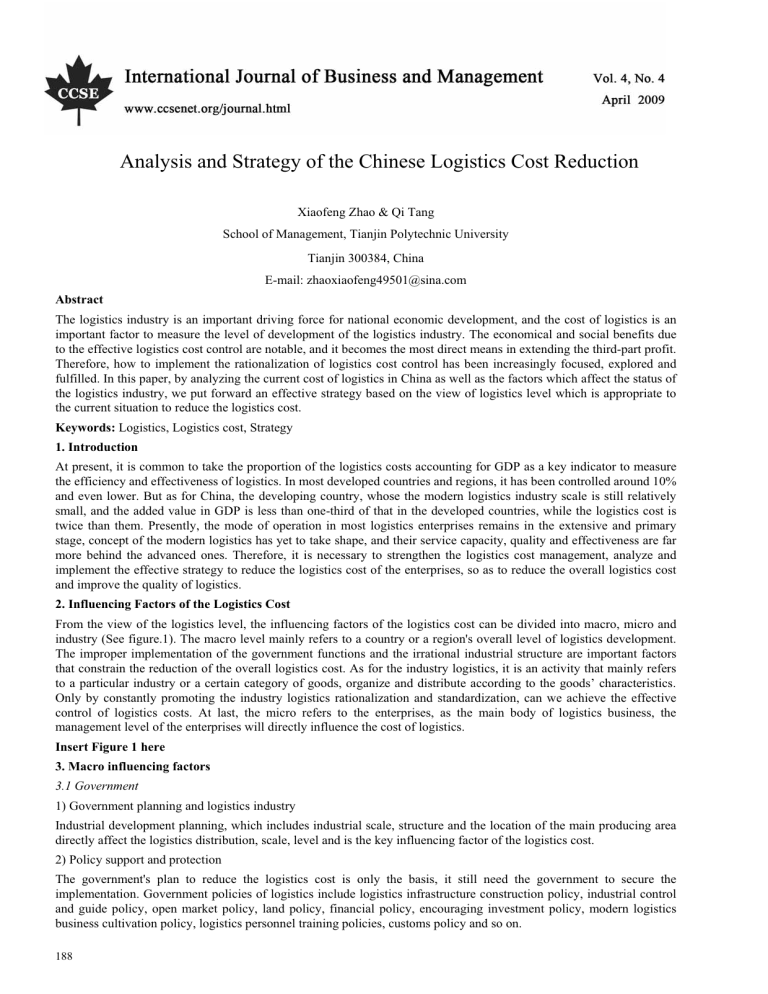
International Journal of Business and Management Vol. 4, No. 4 Analysis and Strategy of the Chinese Logistics Cost Reduction Xiaofeng Zhao & Qi Tang School of Management, Tianjin Polytechnic University Tianjin 300384, China E-mail: zhaoxiaofeng49501@sina.com Abstract The logistics industry is an important driving force for national economic development, and the cost of logistics is an important factor to measure the level of development of the logistics industry. The economical and social benefits due to the effective logistics cost control are notable, and it becomes the most direct means in extending the third-part profit. Therefore, how to implement the rationalization of logistics cost control has been increasingly focused, explored and fulfilled. In this paper, by analyzing the current cost of logistics in China as well as the factors which affect the status of the logistics industry, we put forward an effective strategy based on the view of logistics level which is appropriate to the current situation to reduce the logistics cost. Keywords: Logistics, Logistics cost, Strategy 1. Introduction At present, it is common to take the proportion of the logistics costs accounting for GDP as a key indicator to measure the efficiency and effectiveness of logistics. In most developed countries and regions, it has been controlled around 10% and even lower. But as for China, the developing country, whose the modern logistics industry scale is still relatively small, and the added value in GDP is less than one-third of that in the developed countries, while the logistics cost is twice than them. Presently, the mode of operation in most logistics enterprises remains in the extensive and primary stage, concept of the modern logistics has yet to take shape, and their service capacity, quality and effectiveness are far more behind the advanced ones. Therefore, it is necessary to strengthen the logistics cost management, analyze and implement the effective strategy to reduce the logistics cost of the enterprises, so as to reduce the overall logistics cost and improve the quality of logistics. 2. Influencing Factors of the Logistics Cost From the view of the logistics level, the influencing factors of the logistics cost can be divided into macro, micro and industry (See figure.1). The macro level mainly refers to a country or a region's overall level of logistics development. The improper implementation of the government functions and the irrational industrial structure are important factors that constrain the reduction of the overall logistics cost. As for the industry logistics, it is an activity that mainly refers to a particular industry or a certain category of goods, organize and distribute according to the goods’ characteristics. Only by constantly promoting the industry logistics rationalization and standardization, can we achieve the effective control of logistics costs. At last, the micro refers to the enterprises, as the main body of logistics business, the management level of the enterprises will directly influence the cost of logistics. Insert Figure 1 here 3. Macro influencing factors 3.1 Government 1) Government planning and logistics industry Industrial development planning, which includes industrial scale, structure and the location of the main producing area directly affect the logistics distribution, scale, level and is the key influencing factor of the logistics cost. 2) Policy support and protection The government's plan to reduce the logistics cost is only the basis, it still need the government to secure the implementation. Government policies of logistics include logistics infrastructure construction policy, industrial control and guide policy, open market policy, land policy, financial policy, encouraging investment policy, modern logistics business cultivation policy, logistics personnel training policies, customs policy and so on. 188 International Journal of Business and Management April, 2009 3) Orderliness of government management In China, the phenomenon of cross-department, cross-industry and cross-regional is very prominent. Right now, the serious fragmentation problem among the industries or sectors has hampered the scientific and rational allocation and the full play of the social advantages of the existing logistics resources, which bounds the development of logistics industry. And it is contradicting with the modern logistics’ systematic and network operation. As a result, it has caused the poor logistics system compatibility, information blockade and increased cost. Furthermore, it is not conducive to the integration of logistics resources and form the large-scale enterprises. 3.2 Industrial Structure A country's industrial structure is also an important factor that affects proportion of the logistics cost accounting for GDP. In the composition of the cost of logistics, transportation and stock cost can account for 85%. So it can be proved that if the logistics cost is high, the transportation and stock cost is also high, and vice versa. From various industry's demand for the logistics services, The manufacturing and mining industry which belong to the secondary industry provide the physical shape products that they can not be separated from the transportation and storage in the process of production and consumption. In consequence, the secondary industry demands for greater transportation and storage, and its logistics cost is relatively high. On the contrary, the tertiary industry which is service-oriented, the output value mainly from the intangible services, is less dependent on the logistics. Therefore the logistics cost is low and compared with output value it represents part a very small proportion. So that we can come to the conclusion that the logistics cost of the regions which are orientated by the secondary industry accounts for larger proportion of GDP than the ones which is orientated by the tertiary industry. Even if the two regions have different levels of logistics development, the part of the logistics costs proportion is bound to be influenced by industrial structure. 3.3 The Strategy of the macro logistics cost reduction Government should do overall planning, increase the investment and support the development of logistics enterprises. The rationality of Logistics system planning, distribution, as well as the convenience of distribution channels is of vital importance to logistics costs. Logistics system plan and management as a whole must be carried out scientifically and effectively. And with the use of advanced logistics technology, it can ensure the whole logistic system efficient and low-cost. Therefore the Government should do a good job in the city and the whole country's logistics development planning first. The logistics development planning involves in making coordinate and matched strategy among the industrial structure, economic and social development and the logistics, the logistics infrastructure planning, logistics distribution system planning, logistics information platform planning, establishing the logistics development policy. Then on the basis of the appropriate logistics development policy, the government should also set up the specialized logistics management department and logistics trade associations. So that the government can achieve overall coordination in logistics planning, logistics policy establishing, implementing and logistics services, and ultimately reduce the macro logistics cost. Second, the government should also increase the investment in logistics infrastructure, introduce advanced equipment to improve the existing logistics level, optimize and integrated the existing infrastructure, transform and upgrade the existing resources and give full play to the comprehensive effectiveness of existing facilities. Finally, the government should support the development of logistics enterprises in order to promote the optimization of industrial structure. Firstly, it is necessary to encourage the manufacture and circulation enterprises business to transform their processes, separate and outsourcing non-core business, so that can focus on developing the core business; second, it is essential to speed up the development and cultivation of the professional logistics service businesses, and relax the market access; encourage the transportation, warehousing, distribution, freight forwarders, multimodal transport enterprises through equity participation, mergers, joint venture and other forms to carry out the asset restructuring, gradually build up some cross-border, cross-ownership of large-scale professional logistics business which is high-level service and international competitive; the third is to use information technology to promote Logistics modernization, largely develop the e-logistics and prompt the information sharing; the last is to positively develop the transportation service mode that meets the logistics operation. Through developing multimodal transport, container transport, bulk cargo transport, air transport, using a variety of special vehicles, speeding up the building the transit point for container and bulk terminal, we can make more specialized logistics enterprises achieve rapid development, so that the scale of operation, the use of the advanced technology and automation equipment are all possible and feasible. At the same time, these large-scale logistics enterprises a gradually form a network of logistics and economic union and ultimately enhance their competitiveness, based on these to optimize the industrial structure of the region. 189 Vol. 4, No. 4 International Journal of Business and Management 4. Influencing Factors of Industry 4.1 Logistics Standardization Logistics standardization which includes the standardization and systematic of package of products, the bar coding of logistics information, and the container unitization of loading, unloading, transportation, storage and so on is an effective measure to reduce the logistics cost and improves the efficiency. Logistics is a comprehensive industry, which involves transportation, packaging, storage, loading, unloading, handling, distribution processing, distribution and information and so on. Chinese modern logistics industry is developed on the basis of the traditional industry. As the traditional logistics were artificially separated for a lot of stages and all them can not converge and coordinate well, combined with the blocked information sharing, low level of standardization of the industrial logistics, decentralized management and small-scale, so resulting in inefficient and high costs. 4.2 The Strategy of the Industrial Logistics Cost Reduction The establishment of the standardization of the logistics facility should be in accordance with prevailing international practice and national standard-setting. Then take the whole logistics system as a starting point to study the coordination of the technical and work standards in the various sub-systems and sub-fields, so that to uniform the standard for the entire logistics system. Meanwhile study the coordination between the logistics system and other related systems, to seek the uniform standard for the large logistics system. The specific measures include logistics facility and related technical equipment normalization, implementation of the standard terms of logistics, unified technical standards and technical management standards for the industrial logistics, the unification of industrial equipment standard, the adoption of the same summons, and specification of goods, policy and regulation as well as the reunification of the tray. 5. The Influencing Factor of Micro Logistics Cost 5.1 Enterprises 1) The level of the information and integrated management of enterprises in China is generally low. Moreover, the enterprises are lack of infrastructures and logistics talents, and have the poor technology and equipment. 2) The low level of logistics management and service, which lead to high cost. Given the lack of unified planning, it results in the redundant construction. Due to the Market development lagging behind, the most logistics enterprises are in small, many, scattered and weak condition, they don’t form an effective social service network. 3) Logistics companies generally do not adopt the total cost control, which has lead to logistics cost fuzzy, logistics cost accounting system guidelines and reputations unclear. When the cost is checked by different sectors, it is not clear enough. The scope and content of logistics cost are not comprehensive, only involve in part of logistics cost, which affect the authenticity of accounting information and is not conducive to the stakeholders to make the right decisions. At the same time, in many enterprises the logistics cost is only a part of the indirect cost of them. These factors have seriously hampered the development of the logistics business, so it is high time that took effective measures to change this situation. 5.2 The Strategy of the Micro Logistics Cost Reduction 5.2.1 The Implementation of the Total Supply Chain Management Firms today increasingly consider total supply chain management to be a major vehicle to gain a competitive advantage in turbulent markets. By implementing the total supply chain management, the flow of goods especially the unnecessary duplication processes can be streamlined. For example, through adopting the total supply chain management in the circulation of goods, the supply chain composed by the manufacturers, third party logistics companies, sales businesses and consumers can become a whole system, and then achieve the integrated logistics. To link the logistics activities from the total supply chain, and focus on the interaction and coordination among various logistics links, especially on the middle links(such as the scientific inventory management which can reduce the inventory cost; outsourcing which can shorten the in-transit time of goods, reduce the flow of goods and the cost and losses of this process; efficient distribution which can reduce the distribution cost of transportation by decreasing the transport, increasing the rate of loading ,arranging reasonably for the allocation plan of vehicles and choosing the best routes and means of delivery, etc.). On this basis above and with the help of the modern information management system to achieve the optimal control for all as the logistics links, and make all the links processing become more accurate and fast. 5.2.2 Virtual Logistics Enterprises Strategy Alliance and Prompt the Development of the Third party Logistics Logistics outsourcing is beneficial to the enterprises to reduce the logistic cost effectively and develop their core businesses, accelerate restructuring and achieve scale benefit with the limited resources. As a result, the logistics business outsourcing is an inevitable choice for enterprises to reduce the cost, while the vigorous promotion of development of third party logistics will play a key role. 190 International Journal of Business and Management April, 2009 Accelerating the development of third party logistics enterprises is a requirement to achieve the logistics socialization and specialization and the fundamental way to reduce the cost. Now in China, small-scale, narrow scope of business, poor management, low level of logistics information and technology and the lack of personnel is a widespread problem in the third party logistic. In order to change this situation, the traditional ways are to change the management idea, strengthen the management foundation, introduce logistics personnel and advanced logistics technologies, and optimize the allocation of logistics resources. But there is another effective new way which is to form virtual logistics strategic alliance between the third-party logistics companies. Inline with the “complement each other and benefit-sharing "principle, the enterprises cooperate each other, expand logistics market and improve the logistics efficiency, so that cultivate an internationally competitive third party logistics group and finally reduce the logistics cost. 5.2.3 Strengthen the Logistics Cost Checking Through the logistics cost checking, we can fully reveal the full cost of logistics activities, and raise the person awareness for the importance of logistics cost, thus to achieve the aim of prompting logistics management, reducing the cost and improving the efficiency. So in order to carry out logistics cost control better, and propose logistics cost improvement measures, we must accurately implement the logistics cost checking as follows: 1) The norms and calculation standard of logistics cost checking should be made as soon as possible, which can provide timely and accurate information support for the logistics management and decision-making. 2) Setting up a specialized logistics accounting management and supervision institution. The logistics accounting management is an important part of the logistics industrial management, so the specialized institution should be set up timely to supervise and manage the logistics accounting. 3) Enterprises should establish and perfect the personal responsibility for logistics cost control and regulate the operation of the cost control, including the logistics cost forecast, check, control, analysis and logistics cost information feedback, and so on. 4) Enterprises should build specialized channels to disclose the logistics accounting information to enable the accounting information be completely, timely and accurately received by the business management and relative government administration, which is helpful to implement the proactive monitor and management. References Beamon and B. M. (1998). Supply chain design and analysis: models and methods. International Journal of Production Economics, 55, 281-294. Chopra S. (2001). Supply Chain Management: Strategy, Planning and Operation. New York: Prentice hall, 268-274. Martin Christopher. (1998). Logistics and Supply Chain Management-Strategies for Reducing Cost and Improving Service. New York: Prentice Hall, 266-269. Muckstadt, J. A., Murray, D. H., Rappold, J. A., & Collins, D. E. (2001). Guidelines for collaborative supply chain system design and operation[Special issue: supply chain management. Information Systems Frontiers, 3(4), 427–453. Yim Yu Wong, Thomas E. Maher et al. (2000). Strategic Alliances in Logistics Outsourcing. Asia Pacific Journal of Marketing and Logistics, 3-17. Influencing Factors of Logistics Cost Macro Government Industry Micro Industrial Logistics Enterprises Structure Standardization Figure 1. The Analysis of Influencing Factors 191
